Discover everything about pointing dogs in this comprehensive guide. Learn about the diversity among breeds, their natural instincts, how to train and care for them, and why pointing dogs make excellent hunting dogs. Explore their rich history, the unique traits of each breed, and the vital role they play in the field.
Introduction
Imagine standing in a field at dawn, the morning mist still hanging in the air, and watching as your dog freezes mid-step, nose pointed, body tense with anticipation. This is the magic of pointing dogs, bred to point, born to hunt. These remarkable canines have been hunting companions for centuries, their instincts honed through generations of selective breeding.
From the vast moors of England to the rolling plains of America, pointing dogs have a storied history. Their origins trace back to ancient times when hunters relied on their keen senses and unwavering focus. Over the years, these dogs have developed not just as hunters but as loyal companions, leaving an indelible mark on the world of hunting.
In this post, we’ll delve into the rich legacy of pointing dogs. Whether you’re a seasoned hunter or just curious about these fascinating dogs, you’re in for a wealth of valuable information. Let’s begin our journey into the world of pointing dogs.
The Natural Instincts of Pointing Dogs
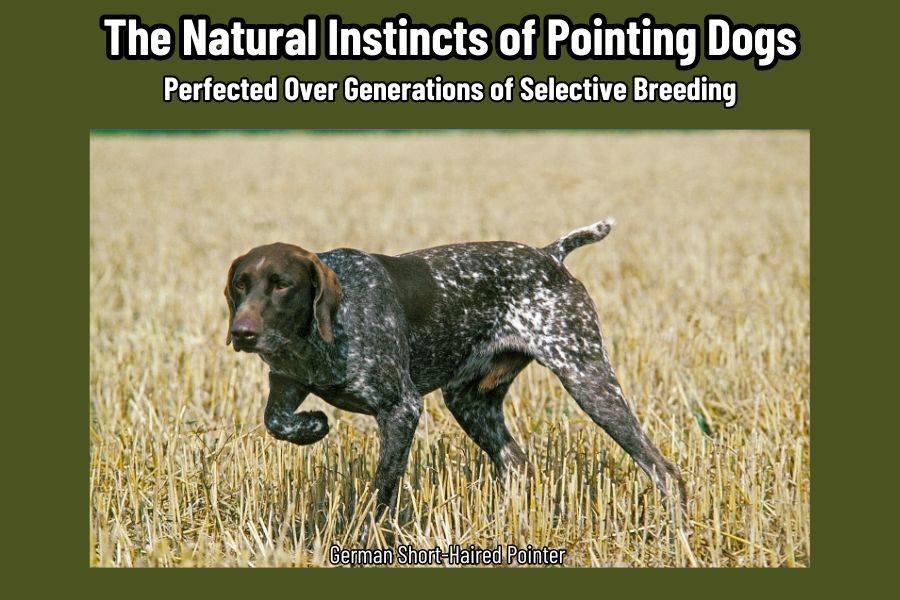
When it comes to pointing dogs, their instincts are nothing short of extraordinary. These dogs are not just trained; they’re born with a natural ability to find and indicate game. Their instincts are a blend of nature and nurture, honed through generations of selective breeding.
Understanding The Pointing and Backing Instincts
The pointing instinct is the hallmark of these remarkable dogs. It’s an almost magical sight: a dog pointing or suddenly freezing its entire body rigid, eyes locked on the target and tail straight out. This behavior, known as “pointing,” is an innate response triggered by the scent of game birds. Pointing dogs are trained to perfect this stance, holding it until the hunter is ready to approach and flush the birds.
Equally important is the “backing” instinct. When a pointing dog sees another dog pointing, it will also freeze and hold its position. This behavior is essential for maintaining order during a hunt, preventing dogs from rushing in and disrupting the point. The backing instinct shows the teamwork and discipline that are integral to successful hunting with pointing dogs.
Selectively Bred from Dogs with Abundant Pointing and Backing Instinct
The exceptional abilities of pointing dogs are no accident. They are the result of meticulous selective breeding. For centuries, hunters have chosen dogs with the strongest pointing and backing instincts to pass on their genes. This careful selection has produced breeds with a powerful natural inclination to point and back.
Interestingly, this breeding process has a storied tradition. In the 19th century, English hunters were known to test their dogs’ instincts rigorously, ensuring only the best were bred. They valued traits like steadiness, scenting ability, and an unwavering focus on the hunt. These practices have been refined over the years, leading to the exceptional pointing dogs we know today.
For those interested in gundogs, it’s fascinating to note that the instinct to point is not something that can be entirely taught. While training can enhance and refine this behavior, the best pointing dogs are those with a natural-born talent for it. This combination of breeding and training is what makes these dogs such invaluable partners in the field.
The Role of Pointing Dogs
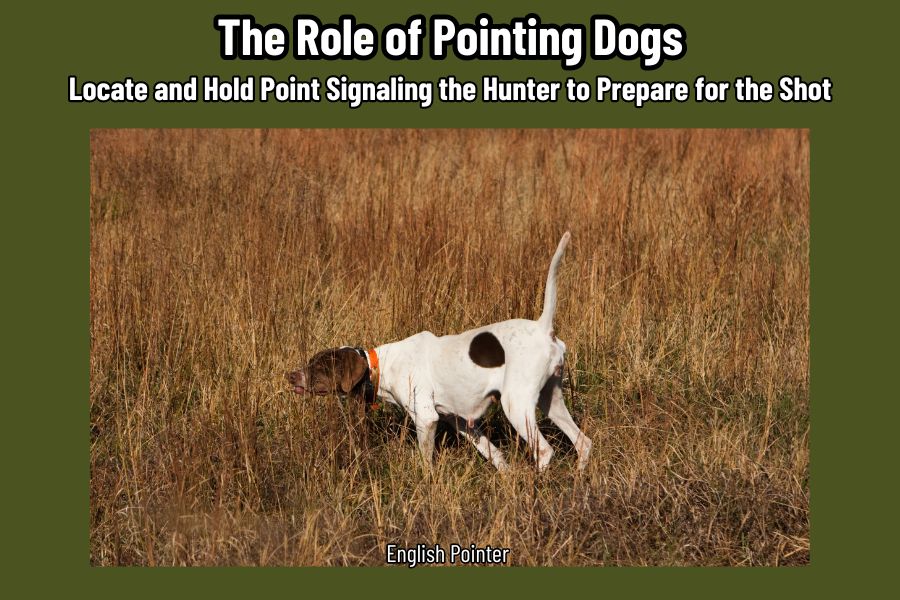
Pointing dogs are much more than just pets; they are strategic partners in the field, bringing a unique set of skills that enhance every hunt.
Pointers Locate and Hold Point
Pointing dogs are primarily bred as gundogs, with an unwavering focus on their task. When out in the field, their primary goal is to locate birds. Once they catch the scent, they move with purpose, locking onto their target with remarkable precision. The dog then holds this “point” position, remaining completely still, signaling the hunter to prepare for the shot. This act allows the hunter to move into gun range, flush out the birds, and take the best shot.
A fascinating fact about pointers is their incredible olfactory abilities. They can detect the scent of birds from impressive distances, sometimes even hundreds of yards away. This ability is not only vital for locating game but also adds a thrilling element to the hunt, as the dog’s behavior becomes an intricate dance of focus and anticipation.
Field Tactics: Pointing Dogs in Action
The operational use of pointing dogs varies across different hunting scenarios. Whether hunting in dense forests, open fields, or marshlands, these dogs adapt their tactics to suit the environment and game.
In the field, hunters employ several strategies to optimize their success with pointing dogs. One popular tactic is “quartering,” where the dog moves back and forth across the field in a systematic pattern, covering ground thoroughly and ensuring no bird goes unnoticed. This method is particularly effective in large, open areas where game birds are more spread out.
Another strategy is using hand signals and whistles to communicate with the dog, guiding its movements and ensuring it stays within the desired range. This communication is crucial in maintaining control and coordination during the hunt.
The role of pointing dogs in the field is a blend of ancient tradition and modern techniques.
Why Pointers Make Great Hunting Dogs?

Pointing dogs are celebrated for their unparalleled hunting prowess, combining physical and behavioral traits that make them exceptional companions in the field. Let’s explore what sets these dogs apart and why they are the top choice for hunters worldwide.
Physical Traits Common to Pointing Breeds
The physical attributes of pointing dogs are tailored for their role as elite hunters. They typically have a medium to large build, with an athletic and muscular physique that allows for endurance and agility in various terrains. Their size ranges from about 40 to 70 pounds, making them robust enough to cover long distances without fatigue.
Their heads are often well-proportioned with a strong, broad muzzle ideal for scent detection. The coat of a pointing dog can vary depending on the breed but is generally short and dense, providing protection against the elements without hindering their movement. For example, the German Shorthaired Pointer has a short, water-resistant coat, while the Wirehaired Pointing Griffon boasts a rough, weather-resistant coat.
Eyes are typically sharp and expressive, reflecting their keen intelligence and alertness. A pointing dog’s memory and hearing are highly developed, essential for remembering commands and detecting subtle sounds in the field. Most notably, their noses are incredibly sensitive, capable of picking up faint scents that would be imperceptible to humans. This extraordinary olfactory ability is a cornerstone of their hunting skills.
Pointing dogs are generally healthy breeds, with a life expectancy of around 13-14 years. Their robust health and vitality ensure they can accompany hunters for many seasons, forming lasting partnerships that are both practical and rewarding.
Behavioral Traits Common to Pointing Breeds
The behavioral traits of pointing dogs are just as impressive as their physical ones, making them not only excellent hunters but also wonderful companions. They are known for their adaptability, seamlessly adjusting to different environments and hunting conditions. This trait is particularly useful for hunters who venture into various terrains and climates.
Obedience is a hallmark of these dogs. They respond well to training and are eager to please their handlers. This obedience is paired with an even temperament, which makes them reliable and predictable in the field. Despite their calm demeanor, pointing dogs are extremely active and require regular exercise to keep them happy and healthy.
Patience is another notable trait. They can hold a point for extended periods, waiting for the perfect moment to act. This patience, combined with their strong drive and determination, ensures they stay focused and effective throughout the hunt.
Loyalty is deeply ingrained in pointing dogs. They form strong bonds with their handlers, enhancing the hunting experience with a sense of partnership and trust. This loyalty extends to their families, making them excellent pets. They are known to be gentle and good-natured around children and other animals.
Highly trainable, pointing dogs excel in various training regimens, from basic obedience to advanced hunting techniques. Their eagerness to learn and perform makes training a rewarding experience for both the dog and the handler.
In summary, the combination of physical and behavioral traits makes pointing dogs exceptional hunting partners.
Diversity Among Pointer Dog Breeds
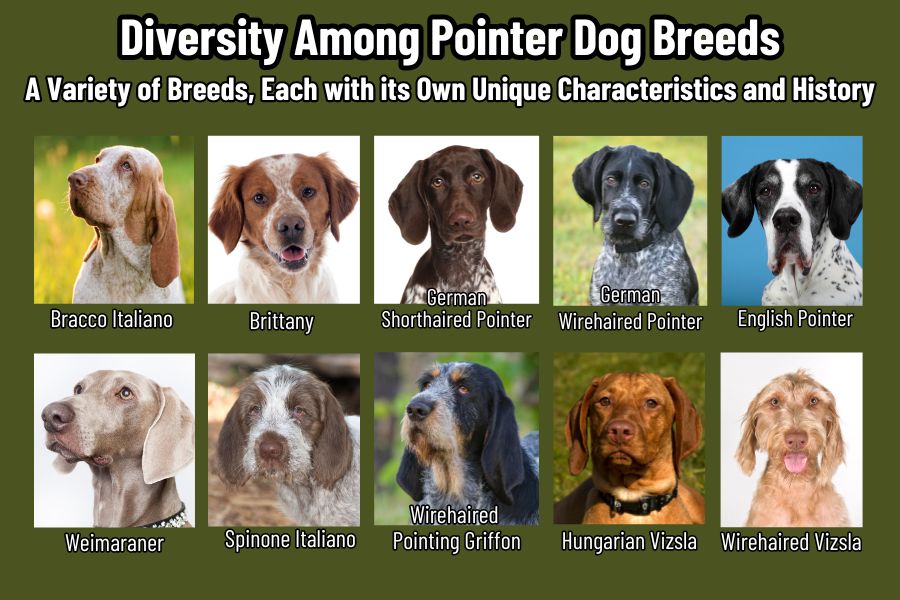
The world of the best pointing dogs is richly diverse, featuring a variety of breeds, each with its own unique characteristics and history. These breeds have been carefully developed over centuries, resulting in a range of dogs perfectly suited for different hunting environments and game. Let’s dive into the fascinating origins and histories of some of the most notable pointing breeds.
Bracco Italiano
The Bracco Italiano is one of the oldest pointing dogs, with roots tracing back to ancient Italy. Originally bred by Italian aristocracy, these dogs were prized for their hunting abilities and noble appearance. Their history dates back to the Renaissance, where they were depicted in artwork and manuscripts. Known for their powerful build and distinctive Roman nose, Braccos are excellent at tracking and pointing game birds.
Brittany
The Brittany pointer, named after the Brittany region in France, is a versatile and energetic pointing breed. Developed in the 19th century, Brittanys were bred by French hunters who wanted a dog that could both point and retrieve. They are medium-sized, with a distinctive orange and white or liver and white coat. Brittanys are known for their speed, agility, and keen nose, making them exceptional bird dogs.
German Shorthaired Pointer
The German Shorthaired Pointer (GSP) is a versatile hunting dog that originated in Germany in the 19th century. Bred for hunting all types of game, GSPs are known for their endurance, intelligence, and keen sense of smell. The GSPs colors are the German shorthaired pointer liver solid color and the combination color of liver and white. Their coats are short and sleek. The German shorthaired pointer is very popular among hunters for their versatility and ability to work in various terrains and weather conditions.
German Wirehaired Pointer
The German Wirehaired Pointer was developed in the late 19th and early 20th centuries by crossing several breeds, including the German Shorthaired Pointer, Pudelpointer, and Griffon. This breed was designed to be a rugged, all-purpose hunting dog capable of working in harsh conditions. German Wirehaired Pointers are distinguished by their dense, wiry coat and bushy eyebrows and beard, which provide protection in rough terrain.
English Pointer
The Pointer, often referred to as the English Pointer, is one of the oldest breeds of pointing dogs. Developed in England in the 17th century, Pointers were bred to find and point game birds. They are known for their elegant and athletic build, with a short coat that comes in various color combinations, including liver, black, and lemon. Pointers are celebrated for their stamina, speed, and precise pointing abilities.
Spinone Italiano
The Spinone Italiano dog, also known simply as the Spinone, is an ancient Italian breed with a history dating back to the Renaissance. Bred for versatility in hunting, the Spinone is a robust and muscular dog with a distinctive wiry coat. Color combinations include solid white, white with brown or orange markings, and brown or orange roan. They are known for their gentle and friendly nature, making them excellent family companions as well as skilled hunters.
Vizsla
The Vizsla, often called the “Hungarian Pointer,” is a breed with a rich history in Hungary. These dogs were bred by Hungarian nobility for their excellent hunting skills and versatility. The Vizsla breed is known for their sleek, golden-rust coat and their affectionate, energetic nature. They excel in pointing and retrieving, and their keen sense of smell makes them invaluable in the field.
Weimaraner
The grey Weimaraner, also known as the “Silver Ghost,” originated in Germany in the early 19th century. Bred by the Weimar court, these dogs were developed for hunting large game like deer and boar. Weimaraners are distinguished by their sleek, silver-gray coat and striking blue or amber eyes. They are known for their speed, endurance, and strong prey drive.
Wirehaired Pointing Griffon
The Wirehaired Pointing Griffon was developed in the late 19th century by a Dutch breeder named Eduard Karel Korthals. Bred to be a versatile hunting dog, the Griffon is known for its dense, wiry coat that provides protection in rough terrain and harsh weather. Although different color combinations exist, the preferred color is steel gray with brown markings. They are excellent pointers and retrievers, known for their intelligence and trainability.
Wirehaired Vizsla
The Wirehaired Vizsla is a relatively new breed, developed in Hungary by crossing the Vizsla with the German Wirehaired Pointer. This breed was created to have the hunting abilities of the Vizsla combined with the rugged coat of the German Wirehaired Pointer. Wirehaired Vizsla breed is known for their stamina, intelligence, and versatility in the field, currently used to point, and retrieve.
Other Pointing Breeds
- Setter Breeds: The English Setter, Gordon Setter, Irish Red and White Setter, and Irish Setter have a long history as upland gun dogs. They are known for their ability to locate and point at upland game birds and flush them on command. See our blog post about [Setter Dogs] for more information.
- Spaniel Breeds: While primarily flushing dogs, Spaniels like Springer Spaniels, Cocker Spaniels, American Water Spaniels, and Boykin Spaniels are well-adapted to finding, flushing, and retrieving a variety of upland game. See our blog post about [Spaniel Dogs] for more information.
The diversity among pointing dogs ensures that there is a breed suited for every hunter’s needs, each bringing unique strengths and characteristics to the hunt. These breeds exemplify the perfect blend of heritage, skill, and companionship.
How do you Train a Pointer Dog to Point?
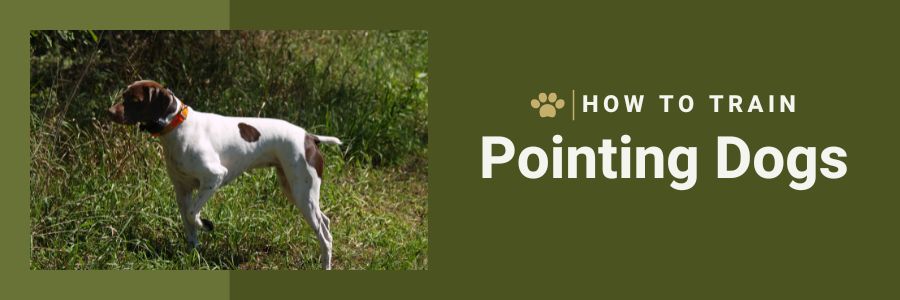
Whether you’re a seasoned trainer or new to the process, understanding the fundamentals and advanced methods can transform your dog into a proficient pointer. Let’s explore some key techniques.
Basic Training Techniques
The foundation of training pointing dogs starts with nurturing their natural instincts. One of the most crucial commands for a pointing dog is the “Whoa” command. This command instructs the dog to stop and remain still, which is essential when the dog points at game. Teaching the “Whoa” command should be the first priority in your training regimen.
Begin training in a controlled environment, free from distractions. Use a lead or training collar to guide your dog into a standing position, gently reinforcing the “Whoa” command. Consistency is key—repeat this exercise multiple times a day, gradually extending the duration the dog holds the position. Positive reinforcement, such as treats and praise, helps solidify this behavior.
As the dog becomes more confident with the “Whoa” command, introduce simulated hunting scenarios. Use bird wings or scent to trigger the dog’s pointing instinct. When the dog points, issue the “Whoa” command to reinforce the connection between the scent and the need to remain still. Over time, this practice will build a strong foundation for more advanced training.
Advanced Training Techniques
Once your dog has mastered the basics, it’s time to move on to some advanced training techniques that enhance their steadiness, precision, and coordination with you as the hunter. Developing these skills ensures that your pointing dog performs reliably in the field.
Steadiness: To improve steadiness, introduce live birds in controlled settings. Allow the dog to point, then use the “Whoa” command to keep them in position. Gradually increase the level of distraction by having other dogs or people present. This helps the dog maintain focus and control even in high-stress environments.
Precision: Precision training involves fine-tuning the dog’s pointing behavior. Use a combination of leash training and off-leash practice to teach the dog to approach birds slowly and carefully. Encourage the dog to lock into a point from a distance, gradually reducing the distance over time. This technique ensures the dog points with precision and does not spook the birds prematurely.
Coordination with the Hunter: Coordination between the hunter and the dog is crucial for a successful hunt. Use hand signals, whistles, and voice commands to communicate with your dog during training. Practice scenarios where the dog must follow your lead, point on command, and retrieve game. This builds a strong partnership and ensures the dog responds accurately to your cues in the field.
Tools: For added effectiveness, consider using tools such as a whistle, training dummy, wings from game birds, remote bird launcher, remote backing dog with transmitter, electric collars, check cords etc. All these tools can help simulate real hunting conditions, allowing the dog to practice pointing and holding in a controlled environment.
Training pointing dogs to harness their natural instincts and become effective hunting partners requires a combination of patience, consistency, and technique. Remember, every dog learns at their own pace, so patience and positive reinforcement are essential throughout the training journey.
Caring for Your Pointing Dog
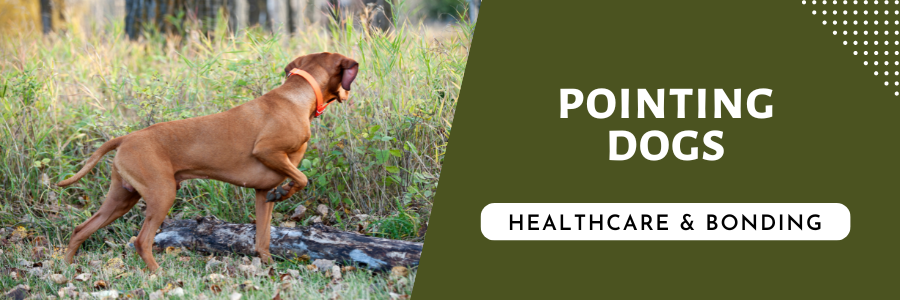
Caring for pointing dogs involves more than just feeding and grooming; it requires a comprehensive approach that includes proper nutrition, preventive care, and fostering a strong bond between hunter and dog.
Health and Wellness: Nutrition and Preventive Care
The nutritional needs of pointing dogs are unique, given their high energy levels and active lifestyle. These dogs require a diet rich in proteins and fats to sustain their stamina during long hunting sessions. High-quality dog food that includes lean meats, fish, and healthy fats like omega-3 and omega-6 fatty acids is ideal. These nutrients support muscle development, joint health, and coat condition.
Feeding schedules should be carefully managed to avoid issues such as bloat, which can be common in active breeds. It’s advisable to feed smaller, more frequent meals rather than one large meal. Additionally, always ensure your dog has access to fresh water, especially during and after hunting activities.
Preventive care is another critical aspect of maintaining your pointing dog’s health. Regular veterinary check-ups, vaccinations, and parasite control (both internal and external) are essential. Given their active nature, pointing dogs are prone to injuries such as cuts, sprains, and strains. It’s important to inspect your dog for any signs of injury after each hunt and provide appropriate care.
Dental health should not be overlooked. Regular brushing and dental chews can help prevent tartar buildup and gum disease, which are common in active dogs. Maintaining your dog’s overall health through preventive care ensures they stay in top form and can enjoy a long, active life.
The Hunter and Dog Bond in the Field and Beyond
The bond between a hunter and their pointing dog is special and multifaceted. This relationship goes beyond the field and is built on trust, mutual respect, and companionship. Fostering a deep connection with your pointing dog enhances their overall well-being.
Training is the foundation of this bond. Consistent, positive reinforcement during training sessions helps build trust and confidence.
Hunting together solidifies this bond further. The shared experience of the hunt, the excitement of the chase, and the satisfaction of a successful point create a unique camaraderie. It’s during these moments that the mutual reliance and understanding between hunter and dog are most evident.
Beyond the field, integrating your pointing dog into your home life is crucial for fostering a strong connection. These dogs thrive on social interaction, playtime and just being part of the family.
Interesting fact: In traditional European hunting societies, pointing dogs were often given honorary titles and treated with great respect. This tradition underscores the deep bond and high regard hunters have for their canine companions.
Conclusion
Pointing dogs make exceptional companions both in the field and at home, embodying a blend of natural instincts, physical prowess, and loyal temperament that sets them apart. Their unique combination of traits makes them invaluable to hunters and cherished by family members.
In the field, pointing dogs are unparalleled hunting partners. Their innate pointing and backing instincts, honed through centuries of selective breeding, allow them to locate and hold game birds with remarkable precision. Their physical attributes—athletic build, keen senses, and endurance—ensure they perform consistently, even in challenging environments.
At home, the appeal of pointing dogs extends beyond their hunting capabilities. They are known for their affectionate, loyal nature, forming deep bonds with their families. Their even temperament and adaptability make them well-suited for family life.
Intriguingly, the tradition of using pointing dogs dates back to ancient times, with historical records and art depicting their roles in noble hunting parties. This rich heritage adds to their mystique and underscores their longstanding traditions.
For those seeking a dog that excels in both performance and companionship, pointing dogs are truly unmatched. Their ability to transition seamlessly from diligent hunters to gentle companions highlights their versatility and enduring appeal.
FAQs: Pointing Dogs
These FAQs cover some of the common questions about pointing dogs, providing insights into their history, training, and roles in hunting.
What is the oldest pointing dog?
The Bracco Italiano is considered one of the oldest pointing dogs. Its origins trace back to ancient Italy, with historical references dating to the Renaissance period. Renowned for its robust build and distinctive Roman nose, the Bracco Italiano was highly prized by Italian nobility for its exceptional hunting skills. Its long history as a reliable hunting companion underscores its enduring legacy and importance in the world of pointing dogs.
What is the smallest pointing dog?
The Brittany is often regarded as the smallest pointing dog. Despite its compact size, typically weighing between 30-40 pounds, the Brittany is a powerhouse in the field. Originating from the Brittany region in France, this breed is known for its agility, speed, and keen sense of smell. Its smaller stature does not hinder its performance; instead, it allows the Brittany to navigate various terrains with ease and efficiency, making it a favorite among hunters who need a versatile and energetic partner.
How far should a pointing dog range?
The range of a pointing dog can vary depending on the breed and the specific hunting environment. Generally, pointing dogs are trained to range between 100-300 yards from the hunter. This distance allows the dog to cover ample ground while remaining within sight and hearing range of the hunter. Some breeds, like the English Pointer, are known for their extensive range and can cover larger areas, making them ideal for open fields and expansive hunting grounds. On the other hand, breeds like the German Shorthaired Pointer tend to stay closer, which is advantageous in dense cover or forested areas.
What is the easiest pointing dog to train?
The German Shorthaired Pointer (GSP) is often cited as one of the easiest pointing dogs to train. Known for its intelligence, eagerness to please, and versatile hunting abilities, the GSP responds well to consistent, positive reinforcement training methods. Their adaptability and quick learning make them a popular choice for both novice and experienced hunters. GSPs excel in various hunting scenarios and can be trained for pointing, retrieving, and even tracking, showcasing their all-around capabilities.
What are flushing dogs?
Flushing dogs are a category of gundogs that are trained to locate game birds and flush them out of hiding, driving them into the air for the hunter to shoot. Unlike pointing dogs, which freeze and point at the game, flushing dogs actively work to disturb the birds from their cover. Popular breeds of flushing dogs include Springer Spaniels, Cocker Spaniels, and American Water Spaniels. These breeds are known for their enthusiasm, energy, and relentless drive, making them excellent companions for hunters who prefer this style of hunting.
Do labs point or flush?
Labradors are primarily known as retrievers and flushing dogs rather than pointing dogs. While they can be trained to perform some pointing behaviors, Labradors are naturally inclined to flush game and retrieve it. Their primary role in hunting is to locate downed game and bring it back to the handler without causing damage. Labradors are valued for their strong swimming abilities, making them particularly useful in waterfowl hunting. Their versatility, intelligence, and gentle disposition also make them excellent family pets and service dogs.
Resources: Pointing Dogs
These resources, both online and in print, offer a wealth of information for anyone interested in pointing dogs, from training tips to breed-specific insights.
SPECIAL NOTE: “The information provided in this post about pointing dogs is based on research using the Resource links listed below. While we try to keep the information for this post current, there are no representations expressed or implied, about the completeness, or accuracy of the information provided. Therefore all hunters should always verify current information from these resources along with other local and federal publications”.
Online Resources
- AKC – American Kennel Club
- TKC – The Kennel Club
- UKC – United Kennel Club
- CKC – Canadian Kennel Club
Best Books
- “Training and Hunting Bird Dogs: How to Become a Professional Trainer” by Kenneth C. Roebuck
This comprehensive guide covers the fundamentals of training pointing dogs for hunting. Roebuck, an experienced trainer, provides step-by-step instructions and valuable insights into the training process. - “The Complete Guide to Bird Dog Training” by John Falk
Falk’s book is a classic in the field, offering practical advice on training pointing dogs. It covers everything from puppy training to advanced hunting techniques, making it a must-read for anyone serious about bird dogs. - “Pointing Dogs: Volume One: The Continentals” by Craig Koshyk
This book provides an in-depth look at various continental pointing breeds. Koshyk explores the history, characteristics, and training of these dogs, complemented by beautiful photography and detailed breed information. - “Gun Dog: Revolutionary Rapid Training Method” by Richard A. Wolters
Wolters’ book is renowned for its innovative approach to training hunting dogs. His methods emphasize speed and efficiency, making this an essential read for hunters looking to train their pointing dogs quickly and effectively. - “The New Complete Brittany” by Maxwell Riddle and Dr. Robert J. Seekins
This book focuses specifically on the Brittany breed, providing detailed information on training, care, and hunting techniques. It is an excellent resource for Brittany enthusiasts and hunters alike.


